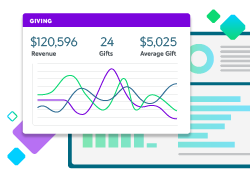Is Your Nonprofit Using Data to Boost Productivity?

Let’s talk about productivity.
Nonprofit leaders need no convincing that this is an exciting topic, but what about frontline fundraisers and marketing teams?
Before we get too ahead of ourselves, let’s make sure we’re all on the same page by defining productivity. According to the U.S. Bureau of Labor Statistics, productivity is a measure of economic performance that compares the amount of goods and services produced (output) with the amount of inputs used to produce those goods and services.
Is everyone excited now?
The unfortunate truth is that Americans are constantly inundated with productivity pressure —productivity in the workplace, productivity at home, productivity while maintaining a healthy work-life balance, productivity in a remote work environment, productivity when returning to an office. —the list goes on.
But how often do we talk about fundraising productivity? Many think of fundraising as more art than science, and understandably so. What’s exciting about data is that applying it doesn’t have to mean devaluing the human element of the art of fundraising. Instead, establishing a foundation of performance metrics and prioritizing strategy development can allow fundraisers to be more effective and spend more time on the things they do best.
Why Fundraiser Productivity Is So Important
Fundraisers often bear the responsibility of facilitating growth for the entire nonprofit. Gift officers have become the visible face of organizational success. Either through rising annual fundraising and campaign goals or increased donor retention and annual giving participation, success for frontline fundraisers often comes down to prioritizing strategy development.
But when information is needed to develop a sound strategy, is the data readily available? Is the technology meant to improve efficiency serving as a barrier to strategy development?
Technology can pose as many productivity challenges as it solves, according to a Gartner/Deloitte report. Highlights from that report:
- Most workers toggle between apps 10 times an hour, costing organizations 32 days per worker, per year of workplace productivity
- Staff spends 25% of their time looking for information they need to do their jobs
- Knowledge workers spend 40% of their time on work about work. That’s 800 hours times 1.25 billion knowledge workers, equaling a trillion hours per year.
This is true for frontline fundraisers, too. A common to-do list in preparation for meetings between fundraisers, internal partners, and external stakeholders might involve the following:
- Reviewing notes and recalling topics from past meetings
- Studying active funds and their guidelines for supporting education, facilities, programmatic, or research needs
- Assessing donations raised to date and available balances for active funds
- Researching past donors, events, campaigns, appeals, and engagement activities associated with active funds
How often does this to-do list involve several emails, phone calls, and data requests to teammates? How many software applications are used to gather the needed data? How much time is spent in this data collection stage?
Instead of coordinating time-consuming steps that reduce productivity, let’s consider the following processes:
1. Applying an assignment structure.
Like traditional portfolio assignments, treating internal partners, external stakeholders and associated funds, campaigns, and appeals as data points can be an effective way to expand the definition of a traditional portfolio beyond only grouping prospective and current donors in a pipeline.
2. Listing pertinent funds, campaigns, and appeals on a report within the CRM.
Create a “one-stop shop” for retrieving the necessary data for productive strategy development meetings. Utilize dynamic reporting that’s filterable by:
- Area
- Type
- Category
- Assignments, etc.
Display metrics for fundraising goal amounts, donations raised to date, and progress toward goals.
3. Utilizing click-through and drill-down reporting. Applying dynamic reporting from within the CRM provides fundraisers, as well as all other parties involved, access to the most valuable data at their convenience:
- General information
- Detailed donation metrics
- Assignments
- Attached guidelines, agreements, and forms
The ability to access detailed and dynamic portfolio management-style reporting from within the nonprofit CRM is a great way to boost productivity through more efficient data-gathering processes.
Processes: Tap Your Data to Streamline Workflows
When I think about using data to boost productivity, my mind quickly shifts to improving decision-making efficiency through streamlining workflows—especially for portfolio and pipeline management. Oftentimes, operations teams frustratingly provide portfolio reports with detailed metrics paired with spreadsheets full of portfolio data, knowing these documents will go unopened and unreviewed.
Why do this? Fundraisers are pressed for time. A deep dive into data analytics and portfolio metrics is time-consuming. We can change this dynamic with a “meet in the middle” approach between fundraisers and operations, reversing the usual order of operations for portfolio and pipeline management.
Consider some common fundraiser scenarios with better-than-typical solutions:
“Let’s cut to the chase: What do I need to work on?”
Before a portfolio review session, operations teammates send fundraisers an email containing a lengthy report or complex spreadsheet, along with a heartfelt “go forth and review when you find the time” message.
This is the exact productivity issue we’re trying to address.
Ditch your attachment to attachments and focus on the very body of the email. It is the perfect place to start a portfolio review session. If portfolio data and metrics are exported out of a CRM, imported into a spreadsheet, and populated into a portfolio management report, then that same data can be converted into plain language and displayed in the body of an email with a simple automation.
Let’s say a fundraiser is below the threshold for two of their five portfolio goals—100 portfolio assignments and 75% portfolio coverage. Format plain language into the body of an email based on their current portfolio metrics, like this:
Your portfolio focus areas:
1. Increase portfolio assignments
2. Increase portfolio coverage
Relying only on a single click, this method leads fundraisers directly to areas of their portfolio needing attention before opening a report or spreadsheet.
“What are my portfolio goals and current metrics?”
After applying a bit of automation to display portfolio areas of attention in the body of an email, the next step is to display a portfolio management report link that contains visualizations for portfolio goals and current metrics.
Concise wins here.
Limit portfolio metrics to four or five items that can be visualized on a single page. This helps leadership, frontline fundraisers, and operations teammates prioritize what’s most important. You are essentially creating a manageable to-do list based on the data and automating it so you have fewer keystrokes and much less effort.
“What are the details?”
Does your organization have a prospective donor pipeline goal? Now is the time to view a list of prospective donors.
Is there a goal for funded major-gift donations? This is when we review pending major-gift asks.
By now, you should sense a theme of getting back to the source—the CRM. Links to visualizations within the portfolio management report take us to a list of specific records in our CRM. That helps build on a “one-stop shop” productivity approach that always nudges teammates to add, update, and review content directly in the CRM.
- Starting with where attention should be focused
- Visualizing why it matters
- Finally ending on specific content
This process is bound to improve productivity by reducing the noise and prioritizing what’s most important.
Donor Engagement: Data Makes it More Efficient and Effective
During a TEDx event discussing Artificial Intelligence and the Future of Generosity, Nathan Chappell said “right now is the most exciting but also the most critical time in philanthropy.” Although this AI presentation took place five years ago; Chappell’s vision was spot-on.
“The future of generosity can collect our clues of inspiration and create a customized roadmap to our philanthropic journey. . . (allowing us to) more deeply engage the causes that are most meaningful to us.”
And this is exactly how modern nonprofit CRMs do it, efficiently collecting datapoints that describe our donor’s inspiration clues as well as their most meaningful causes.
But are we consistently collecting this data? Are we using these datapoints to drive our donor engagement strategy?
One key aspect of improving productivity is time: the effectiveness of how we spend it and the efficiency with which we save it. Using data to build stronger relationships is a great use of our time because it creates opportunities to improve our donor engagement strategy. A focus on collecting both qualitative and quantitative relationship-building data increases the efficiency and effectiveness of subsequent donor engagement activities. Data tells us what’s working:
- Traditional mail and phone calls versus email and social media marketing
- Programmatic support versus endowed scholarship support
- Galas and forums versus 5Ks and radiothons
Each datapoint collected through intentional relationship-building aids in the development of segmented outreach, omnichannel engagement, and personalized communication.
In a way, it’s a circular approach. Using data for efficient and effective donor engagement creates opportunities to build stronger relationships with donors, which in turn provides opportunities to further collect data that improves the efficiency and effectiveness of donor engagement.
Build Your Data Strategy to Ignite Productivity
The nonprofit world is full of professionals with diverse expertise—fundraisers segmented into teams focused on building relationships with annual, mid-size, and major-gift donors; corporate and foundation relations; communications and marketing; finance and operations. You name it, and there’s most likely a department within your nonprofit that focuses on each of these functions.
In that way, we’re not so different from commercial businesses.
Where we differ, though, is that almost every industry in the for-profit sector has prioritized data analytics to boost productivity and drive strategy. The nonprofit world is lagging in these efforts. Specifically, allocations for innovation and technology are major concerns for many nonprofit organizations.
The best way forward for the nonprofit industry should then be to begin and end our processes with data, using technology in a way that always leads us back to the source—our CRM. The key to boosting productivity for nonprofits is creating “one-stop shop” environments. You need data readily available for improving strategy development, for implementing workflows that streamline decision-making, and for building stronger relationships to advance the efficiency and effectiveness of donor engagement.
The Nonprofit CRM Built for Fundraisers
Find out how Blackbaud’s Raiser’s Edge NXT® fits your organization.


